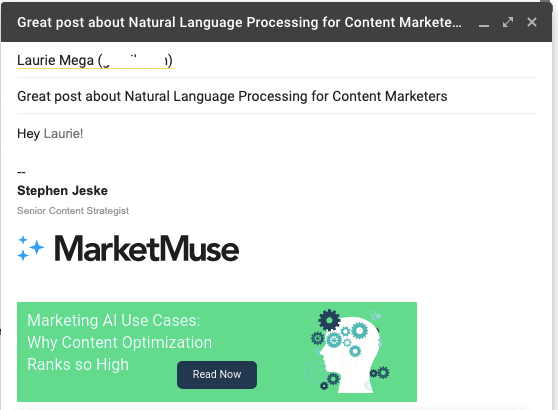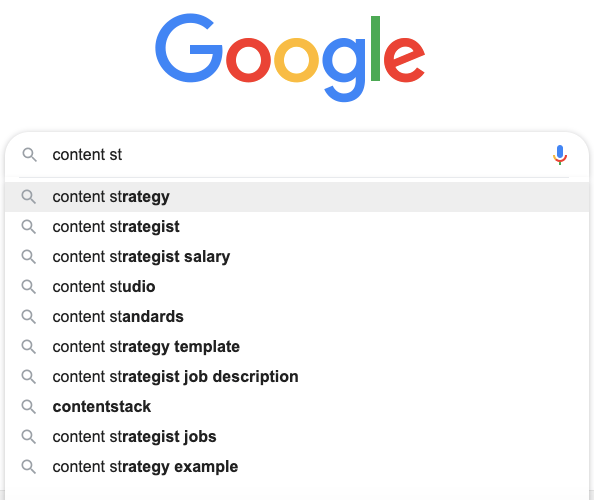Natural Language Processing for Content Marketers
Okay, Google, what’s the temperature outside today? Have you asked your voice-activated device a question today?
Maybe you’ve written an email and used Gmail’s sentence suggestions. Perhaps you translated a page in another language.
If you have, you’ve used a kind of artificial intelligence called natural language processing (NLP), in which computers are programmed to understand human language and speech patterns to carry out commands.
It’s just one part of a group of AI technologies that includes machine learning, image recognition, deep learning, neural networks, and natural language generation (NLG).
Virtual assistants like Google, Siri, and Alexa all use NLP to carry out search queries and requests. Search engines use it, as well, to match content to queries, predict and autofill queries, and deliver targeted ads, among other things.

How Does Natural Language Processing Work?
Before AI and NLP, search engines and websites pretty much did what humans told them to do. They could only “learn” new processes and commands when humans programmed those processes and commands into them.
Now, your phone, voice-command devices, and Chrome can learn how you search for content and the kinds of content you typically look for. By doing so, they try to deliver search terms and content tailored to you and your preferences.
Think of all the search fields you fill out to find what you need. Amazon, Netflix, Google; they all use autofill to figure out what you’re searching for even before you finish typing it.
And how many times have you sort of known the name of a movie or product you’re looking for? You plug in what you know and hope the search functionality can match your partial search term with the thing you’re searching for.
As long as your query is better than “that movie with that guy,” there’s a good chance, Amazon or Google will find it.

And that’s natural language processing. NLP analyzes vast amounts of language data from multiple queries and looks for contextual patterns to interpret results.
Even your email is using NLP now. Have you noticed Gmail now finishes your sentences? It uses machine learning as well as NLP to learn how you communicate and make suggestions as you compose an email.
By the way, if you’re not clear on the difference between natural language processing, generation, and understanding, we wrote a post,“What’s the Difference Between NLP, NLU, and NLG?“ just for you!
What Is the Potential Impact of NLP on Content Marketing?
Think about all the data smart devices and search engines collect on users and their search preferences. Now, imagine you could tap into that data to tailor your own content to it.
That’s exactly what’s happening. Advertisers and content marketers alike can hyper-target their content to specific audiences, based on what the AI behind search is learning.
It’s also affecting the structure of content. Remember the days of cramming unnatural-sounding keywords into blog posts just to appear in search?
NLP and NLG have done away with that. Now, search engines can match content to search terms, even if blog posts use keywords that aren’t an exact match.
And searchers can ask questions using natural language (written or spoken) rather than clunky search terms bookended by quotation marks.
In fact, search engines like Google are using AI and NLP to match quality content to search terms.
Not only does it process your own search habits, but those of all of its users to look for what people search for most. And NLP and AI can interpret big data to find the best search terms for advertisers.
Let’s take a closer look at some of the applications of AI and NLP in content marketing and how they’re changing the field.
Natural Language Processing Applications in Content Marketing
There’s no question NLP is changing how we think about content marketing and content discovery. There are applications marketers are currently using to amp up the kinds of content they’re already producing.
Measuring Sentiment
It’s pretty easy to track how often your content is viewed, shared, and backlinked. But it’s harder to get context for those interactions.
NLP can help marketers understand why their content is being shared. For instance, it’s fantastic when content goes viral. But imagine your content being shared with comments like “this is all wrong,” “how insulting,” or “what were they thinking?”.

This is a big part of a social marketing campaign and social listening. Social media marketers are now using sentiment analysis content to look for negative, positive, or neutral language to help them determine how content is received by target audiences.
Improving Content
If you have a library of existing content, AI and NLP can help you audit your posts for missing or thin content. MarketMuse Suite is a platform that analyzes individual pieces of content, looking for missing topics, subtopics, or keywords.

It will use NLP to help you determine how to improve thin content, as well, by looking for missing information in topics.
Increasing Search Rank
For the last four years, search engines like Google have been using algorithms to crawl content for more than just keywords. These crawlers now use natural language processing to determine whether the content around a keyword is a true match to user intent.
Let’s say your keyword is “how to install shelving.” The crawlers will analyze the syntax and semantics on a page to understand if the rest of the text answers that query. Does it include the right steps? Is it comprehensive enough that a user could install a shelf using your blog post?
And that’s the real crux of search engine optimization. Does your content match user intent? If you write a piece on a hot topic in politics, does your piece match the intent of the user searching for that topic? Does it contain useful information, or is it just fluff? NLP is getting better at determining that.
Reaching the Target Audience
Finally, NLP can help you target the right audience for paid content or advertising. Think of all the data Google collects when people search online or using their smart device. Companies are now tapping into that data to hyper-target their paid content and advertising to particular groups in smaller regions.
Rather than spend money casting a wide net to hook a few fish, companies are honing in on smaller audiences that will yield higher conversions.
In fact, there is a conspiracy theory floating around that your smartphone is listening to your conversations to pick up on keywords and show you targeted content and advertisements. Google and Facebook, of course, have adamantly denied this.
Natural Language Processing Techniques
<a href="https://blog.marketmuse.com/natural-language-processing-techniques-for-content-marketing/"and turns it into usable results through syntax and semantics. Syntax describes how words are arranged in a sentence to make structural and grammatical sense. Semantics refers to the true meaning behind the words a person speaks or writes.
Syntactical Analysis
According to Dr. Michael J. Garbade, founder and CEO of Education Ecosystem, there are more than a few ways search engines and computers derive meaning from syntax. Here are some of the most common techniques:
- Lemmatization – The process of reducing all the inflected forms of a word into a single one to make analysis easier.
- Morphological segmentation – Dividing words into individual units, called morphemes, that make the analysis more straightforward. For example, uptown would be divided into up- and -town.
- Word segmentation – Dividing a large piece of continuous text into distinct units
- Part-of-speech tagging – Identifying the part of speech for every word, such as verbs, nouns, articles, prepositions, etc.
- Parsing – A grammatical analysis of a sentence.
- Sentence breaking – Placing boundaries around sentences to help programs differentiate between one from another.
- Stemming – Cutting inflected words to their root form.

Semantic Analysis
This is where computers and search programs still get tripped up. Because there are so many nuances to language, it’s challenging to program for meaning.
Have you ever shot off a sarcastic remark to Siri? You probably got a literal answer or “I’m sorry. I don’t understand.” That’s because the inflection in your voice, the one that signals sarcasm, can’t be interpreted by voice-activated devices.
But there are some techniques AI technology uses along with semantic analysis to extract meaning, according to Dr. Garbade. They include:
- Named entity recognition (NER) – This is when an algorithm identifies parts of a text or spoken request as part of a pre-defined group. Names of people and places, for example, can be pulled by NER.
- Word sense disambiguation (WSD) – A program looks at a word and tries to determine its meaning in the context of the text around it. Let’s say you wrote in an email, “We went to the party. We had a ball.” Google will look at the text to understand that you mean you had a good time, not that you had a literal ball in your hand.
- Natural language generation (NLG) – This is the process of taking data and turning it into the natural language you hear when you ask Siri or Alexa a question. There’s also emerging technology using NLG for content creation.

Natural Language Processing Tools and Libraries
First, let’s differentiate between tools and libraries. A tool is more of an out-of-the-box solution for NLP, while a library is something your tech team would take and build out an NLP for your brand.
There are open-source options, as well as proprietary code, which means you have to pay for it. What you choose depends on how much customizing you or your development team is willing to do. (Open-source tools and libraries usually require more tweaking.)
Tools
Of course, all of the big names in tech have their own NLP and AI tools and services. Amazon has Amazon Comprehend, which takes large amounts of unstructured data and looks for patterns. IBM has Watson Natural Language Understanding Services. And Google has Cloud Natural Language.
All of these can be used to serve general marketing and big-data needs.
Really, though, there’s only one company using advanced AI and NLP for content marketing, specifically. That’s MarketMuse.
As I mentioned before, MarketMuse analyzes individual pieces or entire libraries of content to look for content gaps, thin content, and even opportunities to one-up competitors.
You can use it to do semantic searches of content to determine your coverage of a particular topic, as well.
Libraries
Libraries are much more technical, but they can give you a little more flexibility in how you implement NLP. Essentially, a library is a coded package of algorithms that you or your development team can use to create your own NLP tools.
Natural Language Toolkit (NLTK) is probably the most talked-about library on the web. It is mainly used for educational and research purposes, and so, is written in python, an open-source program.
Last Words
We’re just beginning to understand the possibilities natural language processing holds for content strategy. As data science becomes an integral part of content marketing strategy, personalization and automated content may eventually become commonplace.
Who knows? It may even replace content creators someday (although this writer genuinely hopes not).
Laurie is a freelance writer, editor, and content consultant and adjunct professor at Fisher College. Her work includes the development and execution of content strategies for B2B and B2C companies, including marketing and audience research, content calendar creation, hiring and managing writers and editors, and SEO optimization. You can connect with her on Twitter or LinkedIn.